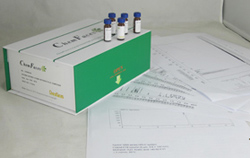Hot Products



| Catalog No. | Information |
| CFN97703 | Kaurenoic acid Kaurenoic acid has anti-inflammatory, analgesic, antimicrobial, cytotoxic and embryotoxic effects; it exerts a uterine relaxant effect acting principally through calcium blockade and in part, by the opening of ATP-sensitive potassium channels. Kaurenoic acid involves the inhibition of cytokine production and activation of the NO-cyclic GMP-protein kinase G-ATP-sensitive potassium channel signaling pathway. |
| CFN92656 | Kawain Kavain has anticonvulsive properties, attenuating vascular smooth muscle contraction through interactions with voltage-dependent Na+ and Ca2+ channels. Kawain is advanced glycation endproduct inhibitors, can increase the mean life span of Caenorhabditis elegans exposed to high glucose. |
| CFN92431 | Kazinol A Kazinol A shows strong inhibition of arachidonic acid (AA)-induced platelet aggregation. It also exhibits potent inhibition with IC50 values ranging 0.6–164 M against XOD. Kazinol A may be a candidate for the development of effective anti-cancer drug on human urinary bladder cancer, it induces cytotoxic effects in human bladder cancer cells, including the cisplatin-resistant T24R2. |
| CFN97569 | Kazinol B Kazinol B inhibits the NO synthesis with an IC(50) of 21.6 microM. It can stimulate respiratory burst, is probably mediated by the synergism of PKC activation and [Ca2+]i elevation in rat neutrophils. Kazinol B stimulates Ca(2+) release from internal Ca(2+) store, probably through the sphingosine 1-phosphate and IP(3) signaling, and activates external Ca(2+) influx mainly through a non-store-operated Ca(2+) entry (non-SOCE) pathway. Kazinol B improves insulin sensitivity via Akt and AMPK activation in 3T3-L1 adipocytes, it might be a therapeutic candidate for diabetes mellitus. |
| CFN97839 | Kazinol U Kazinol U may have therapeutic value in delaying pancreatic β-cell destruction in type 1 diabetes by blocking the NF-κB pathway in pancreatic β-cells reduces cell damage. Kazinol U shows estrogenic activity with ligand-activity of estrogen receptor, transcriptional activity of estrogen -responsive element-reporter genes, it may have beneficial effects in the treatment of menopausal symptoms. |
| CFN90387 | Khasianine Khasianine exhibits strong activity against liver damage induced by CCl4. |
| CFN96394 | Khellactone Khellactone shows antitumor activity,it can suppress the growth of NCI-H460 tumor cells. (+)-4'-cis-Khellactone and (+)-3'-cis-khellactone have antiplasmodial activities, they show notable inhibitory activity against -sensitive strains of with IC(50) values from 1.5 and 2.4 microM. |
| CFN97303 | Khellin Khellin, as photosensitizer, together with ultraviolet A (UVA) irradiation, it can treat vitiligo patients; it does not induce skin phototoxicity with UVA but it induces repigmentation similar to psoralens. Khellin exhibits significant Epidermal Growth Factor Receptor (EGFR) inhibitory activity, it has anti-inflammatory, and analgesic properties, it may be beneficial in the management of kidney stone disease caused by hyperoxaluria. |
| CFN93288 | Kinsenoside Kinsenoside shows significant antihepatotoxic, and anti-inflammatory activities. Kinsenoside could be useful for repairing beta cells in pancreatic islet injury as well as improving its function, it could promote the glucose tolerance of acute glucose increase in both diabetic and normal healthy rats. Kinsenoside inhibits osteoclastogenesis from macrophages by attenuating RANKL-induced NF-κB and NFATc1 activities, which in turn, prevents bone loss from OVX mice. |
| CFN98867 | Kirenol Kirenol possesses anti-bacteria, immunosuppression, anti-obesity, anti-oxidant, anti-inflammatory, anti-allergic, and anti-arthritic activities. Kirenol has significant potential for its discovery as a new lead compound for management of topical pain and inflammation; it can upregulate nuclear Annexin-1 which interacts with NF-κB to attenuate synovial inflammation of collagen-induced arthritis in rats. Kirenol can attenuate experimental autoimmune encephalomyelitis by inhibiting differentiation of Th1 and th17 cells and inducing apoptosis of effector T cells. Kirenol activates the BMP and Wnt/β-catenin signaling pathways. |